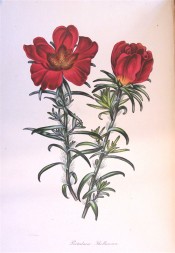Portulaca thellusonii Lindl.
‘These much resemble in appearance an ice-plant, having succulent stems and cylindrical leaves. They are very showy plants, but require greenhouse treatment, although they may occasionally be turned out in the open border in summer. The best [include] Thellusoni, which is the strongest grower – it has large blood-red flowers’ [Gard. Chron. 1855].
Horticultural & Botanical History
‘This exceedingly interesting and somewhat rare plant is now brought forward with the view of calling attention to its great merits. These consist mainly in a capacity for creating a most brilliant display for many months in the year, in a stove, a greenhouse, a frame, or the open border; for in either of these situations it perfects its splendid blossoms throughout the whole of the late summer and early autumnal months. Its habit, too, is particularly dwarf, its flowers very abundant and in rapid succession, and its cultivation extremely easy. Seeds were sent from Florence to the Horticultural Society by the Hon. Frederick Thelluson, now lord Rendlesham; and in the garden of that body, at Chiswick, it first produced its flowers.’ [MB p.29/1841].
Introduced to Britain in 1839. [PD]. See also Portulaca grandiflora Hook. var. splendens.
History at Camden Park
Seed order to Hurst and McMullen, Seedsmen and Florists of London, on 8th April 1846. [MP A2933-1, p.132]. Not known if it was grown in the gardens.
Notes
Published Feb 06, 2009 - 02:31 PM | Last updated Jul 29, 2010 - 05:31 PM
| Family | Portulacaceae |
|---|---|
| Category | |
| Region of origin | South America |
| Synonyms |
|
| Common Name | Portulaca, Purslane, Rose moss, Sun plant |
| Name in the Camden Park Record | Portulaca Thellusonii |
| Confidence level | high |
